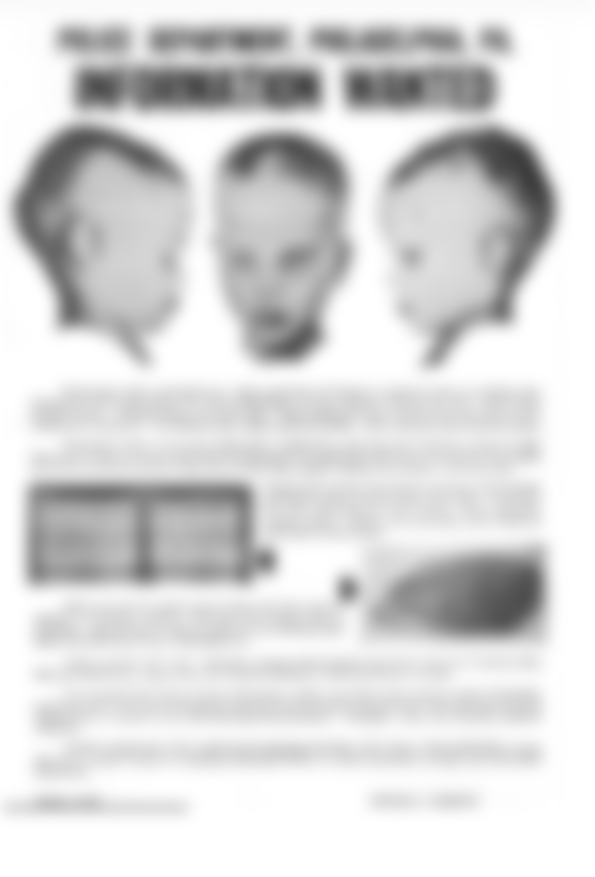The Case of the "American Unknown Child"
Who was the boy found in the cardboard box in the woods of Philadelphia? Why didn't anyone ever ask for it? What tortures did he go through in his short life? If you are interested in the answers to these questions, some of which will remain unanswered, read the following text.
In 1957, in the woods seen in a photo in Philadelphia's Fox Chase neighborhood, poacher John Stachowiak found the body of a little boy, carefully placed in a cardboard box.


It is a type of box that JC Penney started producing in the 1930s, as a kind of deck chair for newborns. As the poacher was in fear of police questions, he did not report the case, but a few days later the boy's body was found by a student. He also did not immediately report finding the dead child. He later changed his mind and contacted police on February 25, 1957. The child found was between 4 and 6 years old. The boy was naked and wrapped in a cheap plaid blanket. His head was full of bruises, and his hair was cut off probably after death. He seemed to have died from a blow to the head. He had several surgical scars on his body: one on his ankle, the other on his groin, and one below his chin very specific in the shape of the letter L. The child's body lay in the woods for several weeks before being found.
Extensive investigation!
Police have launched a case called "American Unknown Child". The investigation was launched on February 26, 1957. Slightly less than 300 recruits from the police academy went to the forest area to look for possible remains related to the boy's murder and abandonment, but all that was found did not provide any new clues. Police also made a photo of the boy showing him what he looked like during his lifetime.


The case received a lot of media attention, and the police produced hundreds of thousands of leaflets in hopes of finding out the child's identity relatively quickly. As is usually the case, police received thousands of reports of his possible identity, but none revealed who the child was from the box. Checking the child’s fingerprints, too, didn’t help. Due to numerous scars on the body, it was assumed that the boy had to be hospitalized before his death, and local hospitals were checked, but that did not help either.

Engaging psychics!
Investigator Remington Bristow devoted himself to the case and led it until his death in 1993. In solving it, over a long period of time, Bristow spent thousands of his dollars and a large amount of free time. Bristow was brought to a dead end regardless of his engagement, which is why he decided to hire a psychic from New Jersey. This one led him to a foster home 3.5 km from the place where the child's body was found. A box similar to the one in which the boy's body was found was later found in the house. On the clothesline he spotted the same kind of cheap blankets with which the boy's body had been wrapped. He believed that the child was the fruit of a bond between the stepfather and his stepdaughter and that they had thus got rid of the unwanted child. As there was no more concrete evidence to substantiate these suspicions, the investigation was closed.
The case is being taken over by a new investigator!
Lieutenant Tom Augustine took over the case in 1998. Augustine decided to return to the first clue that led to the foster family and in doing so hired several retired police officers to interview the foster family. It turned out that, in the meantime, there was a marriage between the stepdaughter and the stepfather. They found that the couple had a child who died of an electric shock the same year the boy's body was found, and the case was confirmed by documentation from the morgue. In the same year, the boy's body was exhumed to take a sample of his DNA.
New track 2002!
A new glimmer of hope emerged nine years after Bristow's death in 2002. Namely, a psychiatrist from Cincinnati contacted police claiming that his patient Martha had information about the murdered child. Martha claimed that her mother, a librarian by profession, was a bully who physically and mentally abused her, as well as a child she bought in 1954 from his parents. Martha was eleven at the time. According to her, the boy's name was Jonathan and he was detained in the basement, malnourished and exposed to physical and psychological violence, as well as sexual abuse. What is interesting is that Martha knew information that the police never released to the public. So she stated that the boy vomited baked beans in the tub, after which her mother hit the child’s head on the floor. Namely, the investigators determined that the remains of roasted beans were found in his stomach, as well as that his hands were wrinkled because he was obviously in the water before his death. She also stated that the boy originally had long hair. Forensic scientist Frank Bender developed the theory that the victim may have been raised as a girl which may be due to the mother’s weirdness as she sexually abused her daughter as well.
Martha told police that her mother forced her to get rid of the child's body after the murder. Her neighbors at the time, as well as her former neighbors, stated that they had never seen the boy, and as the woman was mentally unstable, the investigation reached a "dead end" again.
Try from 2016!
In 2016, two authors, Jim Hoffmann and Louis Romano, connected buyers and sellers of the boy, thanks to the knowledge that a man from Memphis, Tennessee, had sold his son. After that, a DNA analysis of one member of the suspect's family was made, but the following year it was determined that it was not the family of the murdered child.
An American unknown child!
On the boy's grave, instead of the name, there is an inscription "American Unknown Child", and the inhabitants of the city still visit the grave and leave flowers and plush toys on it. Despite the dedication of several investigators, the boy is still not identified.


It is increasingly likely, unfortunately, that the existing inscription will remain on the monument, and that we will never know the final version of the story, although Martha's story has many convincing elements and may provide answers to some of the questions asked. The fact that the neighbors did not see the child does not mean that he did not live in Martha's house, but the fact should be taken into account that the person who told this story was the victim of severe abuse; which is why she was declared an unreliable witness, but the question is who would be mentally stable after such a childhood.






